FLASH SYNCHRONIZATION
The Nikkormat FT2 features an accessory shoe with built-in hot-shoe contact for you
to work with electronic flash units and automatic MX switch-over via shutter speed
selection to facilitate the use of various light sources. Consult the table below
to find out which shutter speeds are acceptable for different types of flashbulbs.
Nikon orig9inal Sppedlight from SB-1 to SB-20 can be accessed by CLIKING HERE
|
The use of various flash bulb (Including X) and proper sync speed |
||||||||||||
|
Flashbulb/Shutter Speeds |
1/1000 |
1/500 |
1/250 |
1/125 |
1/60 |
1/30 |
1/15 |
1/8 |
1/4 |
1/2 |
1 |
B |
|
M |
|
|
|
|
|
|
|
|
|
|
|
|
|
FP |
|
|
|
|
|
|
|
|
|
|
|
|
|
MF |
|
|
|
|
|
|
|
|
|
|
|
|
|
X (For speedlights) |
|
|
|
|
|
|
|
|
|
|
|
|
| Synchronisation | Cannot be used |
Either a bulb- or electronic-type flash unit slides over the accessory shoe on top of the pentaprism housing. Due to the built-in hot-hoe contact, the need for a synch cord is eliminated for units with a hot shoe. For units without a hot shoe, use a synch cord and connect the threaded synch terminal on the camera body to the synch socket on the flash unit. To prevent accidental electrical shock, the safety switch in the accessory shoe turns on only when the flash unit is in place.
Earlier Nikon speedlight units SB-3 and SB-4 can be directly attached to the Nikkormat FT2. For mounting the Nikon speedlight unit SB-2 or flash unit BC-7, use of the flash unit coupler AS-2 is necessary. For details, refer to the instruction manual provided with each unit.
Note: During the era of the Nikkormat, Nikon has some own branded speedlight units like SB-2, SB-3, SB-4 which are designed as companion flash unit to the Nikkormat cameras. This is not an issue as far as flash unit is concerned, virtually any flash (Including the modern AF flash should work fine on the FT-2 on manual and auto mode setting).
 |
Other more popular Nikon flash units like the SB-10, SB-15, SB16AB etc which should be very cheap in the used market are perfect choices, actually, any third party flash units like the Sunpak or Vivitar should be good enough. In any case, both manual OR automatic flash operation is workable. |
Caution:
Flash units without a hot shoe may fire accidentally when being slipped hito place
or when a flashbulb is inserted. Although not recommended, accidental firing may
be prevented by covering the hot-shoe contact on the camera body with electrical
tape
DEPTH OF FIELD
(More info On this specific topic)
Depth of field refers to a zone extending in front of and behind the plane of sharpest
focus. Within this zone blur (or unsharpness of the image) will be negligible and
everything can be accepted as in sharp focus. Depth of field extends a greater distance
behind the subject in focus than in front. Depth of field depends on three factors:
focal length of the lens lens-to-subject distance and taking aperture. The smaller
the aperture and the shorter the focal length of the lens, the greater the depth
of field (for example, wideangle lenses have more depth of field than telephotos).
Also, the closer the subject, the smaller the depth of field. These three factors
can be adjusted independently or in combination to give the photographer creative
control over the final picture.
Depth-of-Field Preview Button
The depth-of-field preview button on all mechanical Nikkormat bodies are un-conventionally
located on top panel of the camera.
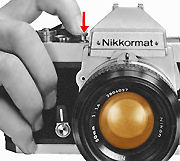 |
It lets you check depth of field before shooting and make desired adjustments. Press the button and the lens stops down to the preselected aperture to allow you to see how much background or foreground is in or out of focus. The more compact Nikon FM has relocate this as a lever to the front of the camera, just as the manual focus electronic FE series models, Nikon F2 and Nikon F3 (Udated). |
DEPTH OF FIELD (additional info)
Depth-of-Field Scale
Depth of field can be read from the color-coded scale engraved on the lens barrel. The pairs of colored lines correspond to f/numbers of the same color. To find the depth of field at a particular aperture first focus the lens on the subject (or set the lens-to-subject distance on the distance scale). Then check the numbers on the distance scale opposite the colored lines which match the taking aperture of the corresponding color to find the depth of field at that aperture.
For example, f/16 on the aperture ring of the 50mrn f/1.4 lens is blue. With the lens prefocused at 15 feet (4.5m), the numbers on the distance scale opposite the blue lines show that depth of field extends from 8 feet (2.4m) to infinity (oo).
By stopping down the lens only, the depth of field can be increased. There are several factors that may affect the degree of depth of field, if you have the time, go to this section - I have some other related info baked for you.
CHANGING THE LENS
To remove the lens from the camera, press the lens release button on the front of the camera body and twist the lens to the right as far as it will go. The lens will come loose and can be lifted out easily.
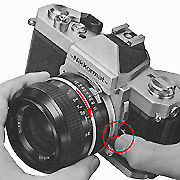 |
Lens Mounting |


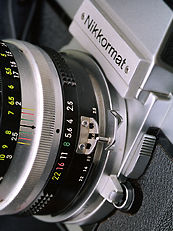 |
First push the camera's coupling pin to the right as far as it will go. Set the lens aperture diaphragm at f/5.6 and insert the lens into the bayonet mount, making sure that the coupling pin fits into the slotted prong on the lens aperture ring. Twist the lens counterclockwise until it locks in place with a sharp click. Now turn the aperture ring all the way to the minimum aperture setting (largest f/number), then all the way in the opposite direction. This step automatically adjusts the meter to the maximum aperture of the lens. |
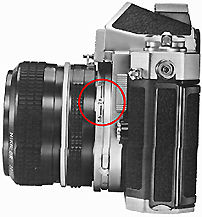 |
Maximum-Aperture Scale |
SELF-TIMER
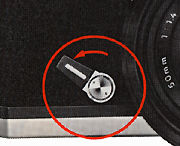 |
The built-in self-timer can be used to trip the shutter in approximately eight seconds delay. To cock the self-timer, turn the lever downward as far as it will go. When the shutter release button is pressed, the timer starts. The self-timer is independent of the shutter mechanism and can be set before or after the shutter is wound. Do not use at "B" setting. |
MIRROR LOCK
Other than the professional bodies of the Nikon F, F2, F3, F4 and the current F5, the Nikkormat series models are the only family within the Nikon SLRs that offer mirror-lock-up for critical vibration free photography.
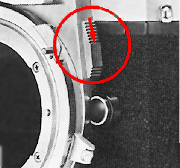 |
Further, the reflex mirror can be locked in the "up" position out of the optical path for use with the Fisheye Nikkor 6mm f/5.6 and the aspherical element OP Fisheye-Nikkor 10mm f/5.6, whose rear elements protrude into the camera body and interfere with the movement of the mirror. Simply slide the mirror lock downward and the mirror will remain locked up. To return the mirror to its original focusing and viewing position, slide the lever up again. |
| Previous | Next | Part 4/5
| Back | to Index Page of Nikkormat FT-2 | Back | to Main Index Page of Nikkormats
History & Background of Nikkormat Cameras
"Nikomat" Picture Library of Japanese local version
Outline the major key features and differences of various models
The Camera Bodies | FT | FS | FTn | EL | FT2 | ELW | FT3 | EL2
| Main Reference
Map
|
HTML Format: FT | FS | FTn | EL | FT2 | ELW | FT3 | EL2 | AW-1 Motor Winder
PDF Format: FT
| FS | FTn | EL | FT2 | ELW | FT3 | EL2 | AW-1 Motor Winder
| Specifications |
FT
| FS | FTn | EL | FT2 | ELW | FT3 | EL2
| Message
Board
| for your favourite Nikkormats
| Message Board |
for your Nikon Optics in a shared environment
| Message Board |
Specifically for Dispose or Looking for Nikon/Nikkor Photographic
Equipment
 |
The Eyes of Nikon:- |
Fisheye-Nikkor Lenses - Circular | Full Frame | Ultrawides Lenses - 13mm15mm18mm20mm | Wideangle Lenses - 24mm28mm35mm |
Standard Lenses - 45mm 50mm 58mm | Telephoto Lenses - 85mm105mm135mm180mm & 200mm |
Super-Telephoto Lenses - 300mm 400mm 500mm 600mm 800mm 1200mm |
Special Application lenses:
Micro-Nikkor Lenses - 50mm~55mm -60mm 85mm -105mm 200mm Micro-Zoom 70-180mm
Perspective Control (PC) - 28mm 35mm PC-Micro 85mm
Dedicated Lenses for Nikon F3AF: AF 80mm f/2.8 | AF 200mm f/3.5 EDIF
Depth of Field Control (DC): 105mm 135mm
Medical Nikkor: 120mm 200mm
Reflex-Nikkor Lenses - 500mm 1000mm 2000mm
Others: Noct Nikkor | OP-Nikkor | UV Nikkor 55mm 105mm | Focusing Units | Bellows-Nikkor 105mm 135mm
Nikon Series E Lenses: 28mm35mm50mm100mm135mm | E-Series Zoom lenses: 36~72mm75~150mm70~210mm
MF Zoom-Nikkor Lenses: 25~50mm | 28~45mm | 28~50mm | 28~85mm | 35~70mm | 36~72mm E | 35~85mm | 35~105mm | 35~135mm |
35~200mm | 43~86mm | 50~135mm | 50~300mm | 70~210mm E | 75~150mm E | 80~200mm | 85~250mm |
100~300mm | 180~600mm | 200~400mm | 200~600mm | 360~1200mm | 1200~1700mm
Tele-Converters: TC-1 | TC-2 | TC-200 | TC-201 | TC-300 | TC-301 | TC-14 | TC-14A | TC-14B | TC-14C | TC-14E | TC-16 | TC-16A | TC-20E
![]()
Nikon F
| Nikon F2 |
Nikon
F3
| Nikon F4 |
Nikon
F5
| Nikon F6 |
Nikkormat / Nikomat |
Nikon FM
| Nikon FE/ FA | Nikon EM/FG/FG20 | Nikon Digital SLRs | Nikon - Other models
MIR Supports for Photographic Community: Various Message Boards/Community
Forums
Nikon
F-series|
Nikon
F2-series|
Nikon
F3-series|
Nikon F4-series| Nikon
F5-series|Nikkormat/Nikomat-series
Nikon FM-series|Nikon
FE-series|Nikon
FA|Nikon
Digital
SLR
series|Various
Nikon
Models|Nikkor
Optic
-shared
Others:- Free Trade Zone - Photography| Free Trade Zone - Business Community |Free To Zouk - Photographic Community
Apple's Mac Public Community Message Board | Windows based PC &
Apple/Mac
Public Community Trade Exchange Centre
Recommended links to understand
more technical details related to the Nikkor F-mount and production Serial Number:
http://rick_oleson.tripod.com/index-153.html by: my friend, Rick Oleson
http://www.zi.ku.dk/personal/lhhansen/photo/fmount.htm by: Hansen, Lars Holst
http://www.mir.com.my/rb/photography/hardwares/nikonfmount/lens2.htm
http://www.photosynthesis.co.nz/nikon/serialno.html
About
this photographic
site.
Home - Photography
In Malaysia
![]()
Copyright
© 1998.
HIURA Shinsaku ® ; Nikomat ML, Japan,
in collaboration with leofoo ®. MIR Web Development Team.
* Credit: A
Great thanks to Mr Denis Pleic for his volunteering
effort to reedit content and and patching some grammatical mistakes found in this
section of the PIM site. Miss
Rissa (Marketing) & Edward
(Techical) of Shriro Malaysia, distributor of Nikon cameras in Malaysia, in providing
so many useful inputs to make this site possible. Mr Hong,
Ipoh for lending me his FT2 to take some of the images used in this site. This site
is created for his eldest son, Yuen who has picked up his father's hobby and
the FT-2. My friend, John Walls from Florida, US for his images of the FTn
body and the Zoom Nikkor
43-86mm.
[Left Brain][Right brain][Home-MIR] [Invention][Art & Design][Clubs]
[Portfolios][On assignments] [Trading room][Knowledge & Resources] [Free-trade-zone][Thoughts & opinions][Links]